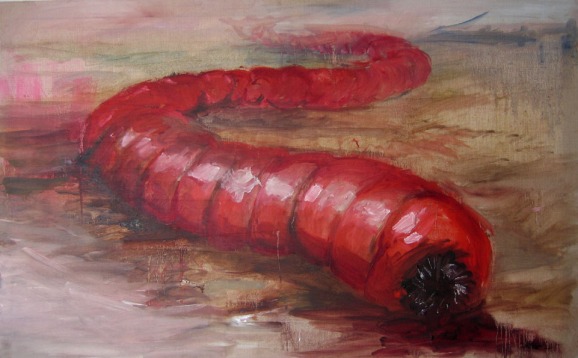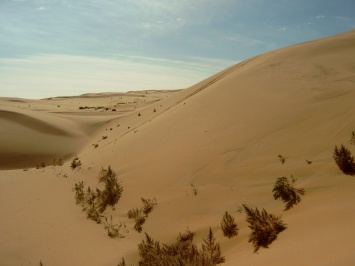Ivan Mackerle–Czech cryptozoologist extraordinaire–was well-known throughout the 1980’s for his work on the Loch Ness monster. But around 1990, his eye turned east, away from wet, green Scotland to the dry sands of the Gobi desert. There was a creature there that the western world had only heard about 50 years before–a species of monster that had never been photographed, and for which physical evidence had never been found, but which the Mongolian nomadic tribes feared and swore was real. Mackerle aimed to find it.
His guide warned him that it would not be safe. Some years ago, the guide said, he had been on a team with another scientist, a geologist visiting the Gobi as part of a field trip. One night the geologist, bored and deep in thought, idly poked an iron rod into the sand. He screamed and crumpled half a second later, dead before he hit the ground. His horrified friends rushed forward to see what had happened, but stopped short when the earth beneath the corpse began to churn. Something heavy and red crested through the sand, and then out burst a fat, hideous, writhing thing: thick as a man’s arm, eyeless, angry. It was the olgoi-khorkhoi, the large intestine worm, or, as it was known to the west: the Mongolian death worm.

Juicy!
Mackerle knew the score. The death worm–reported to grow to almost three feet in length–was said to so aggressive and dangerous that you’d be a fool not to flee from it, never mind look for it. It not only spat a thick yellow acid strong enough to corrode metal; it was said to be able to send electric shocks powerful enough to wipe out an entire herd of camel. Indeed, camel and other livestock were some of its main prey: after they were dead, it would lay its eggs in their intestines, baptizing its spawn blood-red for life.
In the 1920’s, Mongolian Prime Minister Damdinzabar desperately asked Mackerle’s predecessor Roy Chapman Andrews to bring him a specimen to study. “It is shaped like a sausage about two feet long, has no head nor leg and it is so poisonous that merely to touch it means instant death,” the minister described. “It lives in the most desolate parts of the Gobi Desert.”
Andrews swept all over the Western and Southern Gobi, but failed to find anything. He concluded that the creature must just be a myth.
Mackerle wasn’t so sure. Contrary to Andrews’ experience, he was finding that people did not want to talk so much about the worm anymore. They seemed afraid. That just made him want to find it more.

The Gobi desert.
Mackerle gathered enough information to learn that the worm was active mostly in June and July–the hottest months of the year, where temperatures could hit 122 degrees Fahrenheit. He noted that the worm was said to hang out around the strange parasitic plant goyo, from which it might derive its poison. He thought it might leave marks in the sand as it passed–the only warning a traveler might get before it thrust out, bloated, and exploded acid in their face. He borrowed a page out of Dune and tried to summon the creature with vibrations, then with explosions. Nothing ever came. Still, the whispered rumors of the Mongolian nomads infected him–the creature had to be real, he thought. He couldn’t stop looking.
He came back in 1992, this time with more cameras and video equipment to make a documentary. Monks at a buddhist monastery warned him to stop. The creature, they said, was supernaturally evil, and should not be pursued. His life was in danger. Mackerle didn’t listen. There were too many mysterious deaths, too many second-hand stories that coincided too well. Andrews had failed, but he wouldn’t. He was Mackerle, the great cryptozoologist.
Then, one night, he visited the chilly white sands of the Gobi in his dreams. There, at last, he saw the great, red, terrible beast. When he awoke, there were blood-filled boils down his back.
Mackerle never found the worm. Nor did his successors in 2005, 2007, and 2009. Perhaps the creature lived in the forbidden area along the China-Mongolia border, some said. Others claimed it might be a cover-up: conspiracy theories cited a rumor that someone had actually captured a dead specimen, only to have it stolen away by Russian scientists. Regardless of the reason, no one could argue with the result. There was (and still isn’t, to my knowledge) not one shred of proof that the Mongolian death worm existed: even with all modern technology, not so much as a blurry photograph.
Biologists argue that the worm probably could not exist. There are no known land animals that can produce an electric shock–that’s the domain of electric eels and other fish. They also say that the worm could not actually be a *worm*…something that large would need a vertebrae, never mind some kind of outside protection to be able to survive the arid desert. Perhaps the worm is a misidentified snake, or some kind of legless lizard. But if that’s the case, why have we never seen a body? Wouldn’t the desert preserve it perfectly?
Some argue that if the Mongolian death worm ever lived, the lack of recent sightings signal that it’s now gone extinct. I am not so pessimistic. The Gobi desert is rapidly expanding, swallowing 1,390 square miles of grassland a year on its southern edge alone. As usual, humans are to blame. As the sands creep toward more densely populated territory, other things might creep with them. We might get our death worm picture sooner than you think.
What’s the best Instagram filter to bring out the color red?
Have you ever spat into someone’s face before? How about laid your eggs in their intestines? Share your story in the comments below.
ALL IMAGES COURTESY OF WIKIMEDIA COMMONS. (Except for the featured image. That’s from Aaron Katz.





0 Comments
Trackbacks/Pingbacks